Material Animation: ETH Experiments with Electroluminescent Foil
Image courtesy my.firefighternation.com
Manuel Kretzer sent me a description of the project, Material Animation, excerpts from which I’ll share here:
Material Animation is a kinetic light installation made from laser cut electro-luminescent (EL) foils which senses location, number and velocity of human occupants and responds through a multitude of wireless networked components to encourage further interaction with the environment. It merges advanced techniques in parametric design, digital fabrication, physical computing, electronics and material science with theories and computational approaches to machine intelligence and sets them into a real world context.
The experiment is situated in three rooms of an idle emergency bunker below ETH Zürich’s Science City campus. Each room reflects a different theme and approach to physically animate the distinctive material properties at an architectural scale. Electroluminescent foils are extremely thin, flexible and lightweight screens which emit a homogeneous cold light across their surface without the need for additional infrastructure.
So to recap: you enter an unused emergency bunker (danger! – I told you not to take off your helmet!!) and then wind your way through a series of darkened rooms, each of which contains objects that are not alive, but which can sense your presence and respond. Each room is equipped with one Microsoft Kinect Sensor, which is usually used to control the Xbox 360 console using gestures and spoken commands. The device features an RGB camera, depth sensor and multi-array microphone, which provide full-body 3D motion, capture, facial recognition and voice recognition capabilities.
The behavior of the elements in each room depends on the number of people present in each room, their location, movement and speed, and if more than two people are in the same room, also the area of space they occupy. The elements encourage people to interact with the installation, allowing the system to collect real-time feedback. Not only that, but the various installations are connected into a network, so that something going on in one room can trigger activity in another.
Vapor
Vapor creates a fluid space consisting of eight floating elements that are expanding and contracting according to location and amount of users. The main focus was to emphasize the lightness of the material and maximize the three dimensional form which is created through the way that two electroluminescent A4 sheets are cut and combined. Generative design processes and the use of parametric software led to an oval shape that allows top and bottom part to reveal and conceal independently from each other. Each element is controlled and animated by two servo-driven pulleys, which are mounted to the back wall of the room. The servos allow for the expansion and contraction of the top and bottom layer and simultaneously raise the element in space. The speed of movement and frequency of illumination are determined by a Java programmed behavior and the real time input of the sensor system, which are then tuned to the overall performance of the other spaces.
Open Wires
Open Wires aims to create an environment based on lighted, ephemeral and unpredictable three-dimensional shapes. The system consists of 31 EL strips that revolve and flicker in high speed. The strips are attached to the ceiling at two different heights. The first level is overhead, acting as a collective cloud system. The second position is lower and invites the visitors to touch and distort the ray trace. Each element mainly consists of an electroluminescent foil, a square-shaped rotary contact and a DC motor. The motor is fixed to the acrylic structure of the system. Through a metal axis, the rotary contact and the EL foil are attached to the motor. Two fixed open wires power the foil through the rotary contact. The visual impact of Open Wires is affected by both the revolving speed of the motors and the on/off state of the EL strips. The combination of these two factors forms the unpredictable shapes in space.
Insomnia
Insomnia focuses on the flexibility, thinness and homogeneous illumination of the material. These properties are used to back light two separated optical animations based on moiré patterns. This effect appears when two transparent layers containing coherent opaque patterns are overlapped and moved against each other. Each structure consists of an EL layer, printed black and white pictures and a striped pattern, which slides horizontally. The project was approached from three sides. First the flexibility and pliability of the material was explored. Second the optical illusion resulting from the moiré effect and how it tricks and stimulates human perception was analyzed and reproduced. Third a structural and mechanical system was developed that would incorporate and unify the various layers.
Disturbance
Disturbance generates a vividly vibrating structure that appears and disappears and invites the users to pass through and linger among its suspended tentacles. The piece consists of 64 thin electroluminescent strips, which are evenly spread along a circular disk that is fixed to the ceiling of the space. While lit, they form a cylindrical surface that blurs and shivers when it’s being hit by the fast spinning propeller that sits in the center of the disk. Depending on the proximity and location of approaching people light patterns gradually appear and disappear along the round surface. As with the other installations, the piece is networked and adopts its behavior to situations happening in the different rooms.
The project is a case study in the possibilities of Electroluminescence, an optical phenomenon in which light is emitted by a material in response to a strong electric field. Material Animation used EL foils, which are extremely flexible, lightweight, thin screens that can be described as:
flat light bulb sandwiches consisting of layers of conductive and non-conductive plastic and a layer of phosphor. Light is produced when an electric current is passed through a semiconductor with tiny holes. As the excited electrons pass over these holes, they release their energy as photons, which result in a steady glow of the material. Compared to other lighting technologies electroluminescent lights require very little alternating current but a relatively high voltage (between 60 and 600 volts). In contrast to neon lamps, filament lamps or LEDs, electroluminescent light is non-directional, so the brightness of the surface appears consistent from any viewing angle. The emitted light is perfectly homogeneous and visible from a great distance. Because EL sheets are self-contained, there is no further infrastructure needed for installation.
I have filed Material Animation under Fire because of the EL components and all the electronics involved in this fascinating project. Special thanks to Manuel Kretzer for all the info!
Cited:
Kretzer, Manuel. “Material Animation.” CAAD ETH 2011. (Text Excerpts and Images unless noted otherwise).








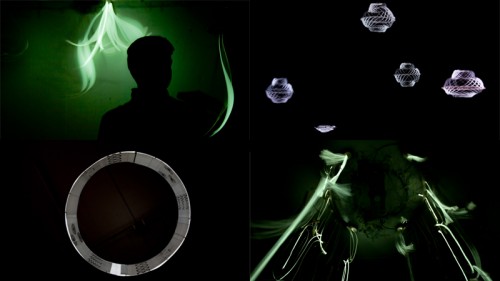
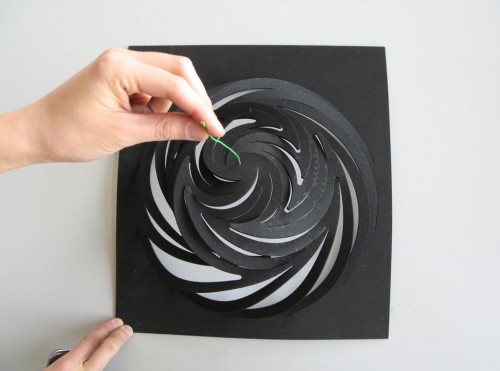
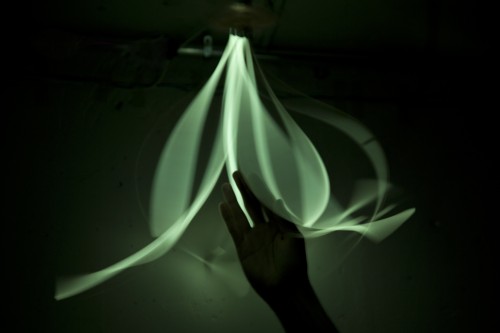
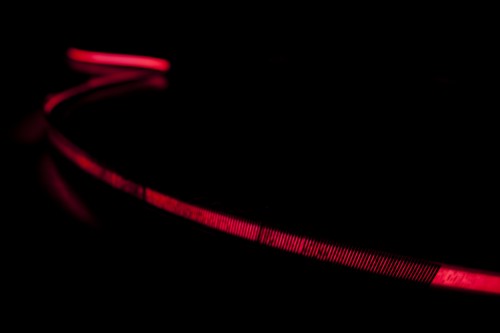
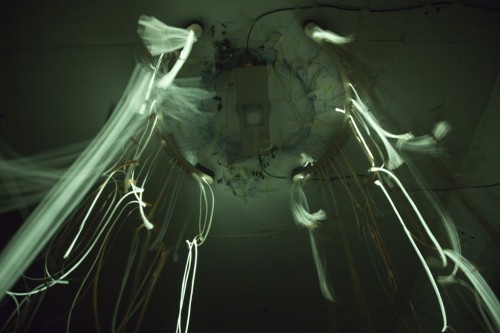
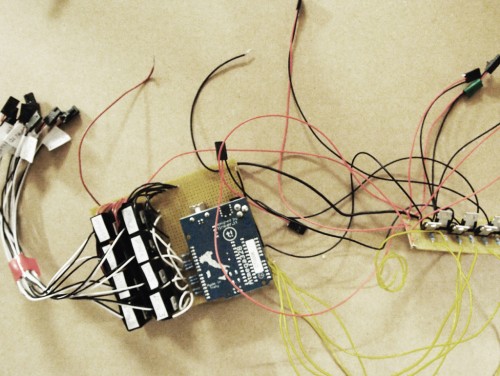









Leave a Wordpress Comment: